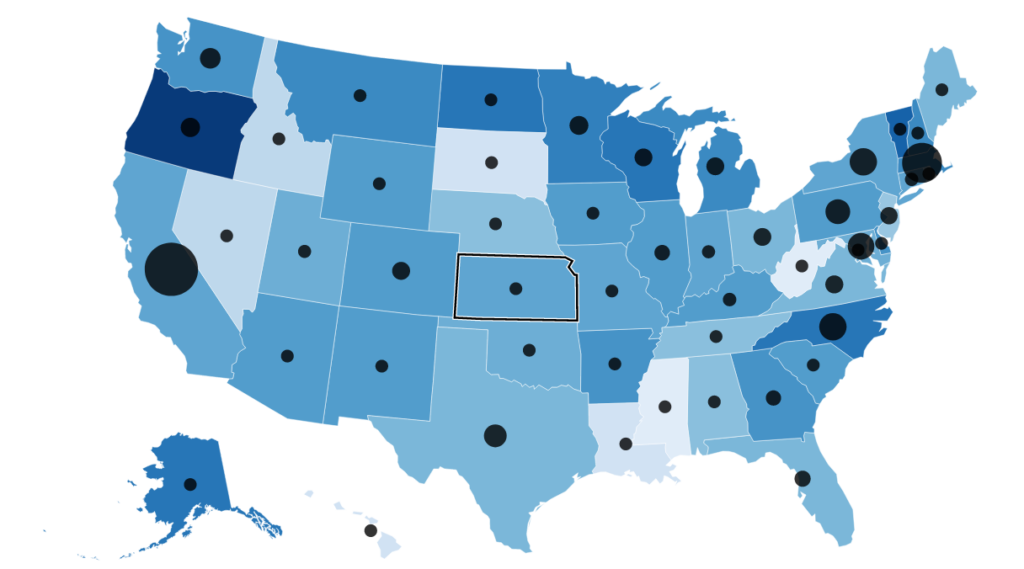NIH SBIR/STTR Application Success Rates and Average Yearly Funding by State (2008-2017)
Shading represents the state’s success rate, while bubble-size represents the average dollar amount of awards per year.
One of the best ways to measure the effectiveness of state programs intended to encourage the success of SBIR applications is the approval-rate of their submissions.
Although this data has been historically unavailable across every federal agency, it is now accessible for the National Institutes of Health (NIH), the second largest provider of SBIR/STTR awards, according to a 2018 Digest report.
The NIH distributed $446.2 million in SBIR/STTR awards in 2017, with every state except North and South Dakota receiving an award.
Although California and Massachusetts had the most successful SBIR/STTR applications in 2017, accounting for roughly one-third of the total when combined, neither state ranked among the top 10 in success rate. NIH SBIR/STTR applications in Oregon (29 percent success rate), Vermont (25 percent success rate), and Wisconsin (23 percent success rate) were the most likely to be approved over the ten-year period from 2008 to 2017.
Each of these states, as well as many others with high success rates, offer assistance with proposals such as technical support programs and Phase 0 grants.
Last year, a Digest report looking at SBIR/STTR awards over the decade from 2008 to 2017 found that the NIH is the second largest distributor of awards after the Department of Defense. A further analysis of this data finds that NIH awards are much less concentrated than those awarded by the DoD. Firms receiving at least 10 awards during the 10-year period received more than half (51 percent) of all DoD SBIR/STTR awards from 2008 to 2017, while similar firms received just 11.6 percent of NIH SBIR/STTR awards, according to an SSTI analysis. The total size of NIH SBIR/STTR awards, the relative lack of concentration, and the availability of plentiful proposal data make the agency ideal for the following Useful Stats analysis.A Flourish data visualisation
The map above shows NIH SBIR/STTR award success by state over the 10-year period from 2008 to 2017. Shading represents the state’s success rate, with darker shades representing a higher approval rate of submissions, while bubble-size represents the average dollar amount of NIH/STTR awards per year.
The states submitting the most proposals that also achieved the highest NIH SBIR/STTR application success rates from 2008 to 2017 were Oregon (28.9 percent, 277/957 proposals), Wisconsin (23.4 percent, 248/1056 proposals), North Carolina (22.7 percent, 549/2420 proposals), Minnesota (21.6 percent, 281/1299 proposals), and Michigan (21.1 percent, 255/1207 proposals). Notably, each of these states has at least one program dedicated to improving SBIR success rates:
- In Oregon, the state’s lead economic development organization, Business Oregon, offers grants to help prepare applications for both the SBIR Phase I and Phase II programs, as well as matching grants. The state-sponsored bioscience incubator OTRADI also offers grant-writing assistance and pro-bono mentorship.
- In Wisconsin, the Center for Technology Commercialization, an organization funded by the University of Wisconsin system and the Wisconsin Economic Development Corporation, offers SBIR Ready, an immersive program for graduate students and early-career scientists that offers workshops, technical assistance, and funds for proposal development.
- The One North Carolina Small Business Program, directed by the state’s Office of Science, Technology, and Innovation, offers matching grants for awardees and previously provided reimbursement for costs incurred during proposal development.
- The Minnesota High Tech Association offers technical and financial assistance through the MN-SBIR program, including proposal preparation courses, mentorship, and other technology transfer resources through the state’s research institutions.
- The Michigan Assistance Program, conducted by the private firm BBC Entrepreneurial Training & Consulting and funded by the Michigan Economic Development Corporation, provides proposal development services to prospective companies, covering most costs. BBC is also the lead business for the newly established Sustainable Heartland Accelerator Regional Partnership Hub, which is explored in this week’s Digest.
The states with fewer proposals but high success rates during those years were Vermont (24.5 percent, 37/141 proposals), North Dakota (22.7 percent, 10/44 proposals), Alaska (22.7 percent, 5/22 proposals), New Hampshire (21.4 percent, 91/426 proposals), and Montana (20.7 percent, 45/217 proposals). Although the programs are less formalized than they are in the other states detailed above, these five states also have programs supporting SBIR:
- The Center for Innovation at the University of North Dakota offers targeted coaching services for prospective SBIR/STTR applicants, while the state’s Department of Commerce has historically invested in early-stage support services through the Innovate ND program.
- The Technology Research and Development Center of Alaska (TREND), a program from the state’s Small Business Development Center, previously offered Phase 0 grants to help with proposal development. The SBDC now provides free advisory services.
- The Vermont Small Business Development Center provides services to prospective SBIR/STTR applicants, including free advising and connections to resources.
- The New Hampshire Innovation Research Center at the University of New Hampshire and the state’s SBDC partner to host periodic workshops for SBIR/STTR proposals.
- The Montana Technology Innovation Partnership (MTIP), powered by Montana State University’s TechLink Center, offers technical assistance for SBIR/STTR proposals such as proposal reviews, IP guidance and referrals, and commercialization planning. MTIP also places an emphasis on helping women-owned, minority-owned, veteran-owned, and rural companies.
As can be seen in the examples above, states with high success rates are not leaving the application process to chance, but are instead investing in the future of their early-stage technology companies. Because nearly every state offers at least some type of assistance to SBIR/STTR applicants, however, more research is needed on the types of these services and their impacts.
Access the whole SSTI article with searchable state-by-state table on NIH SBIR/STTR proposal success, while additional year-by-year data here.

